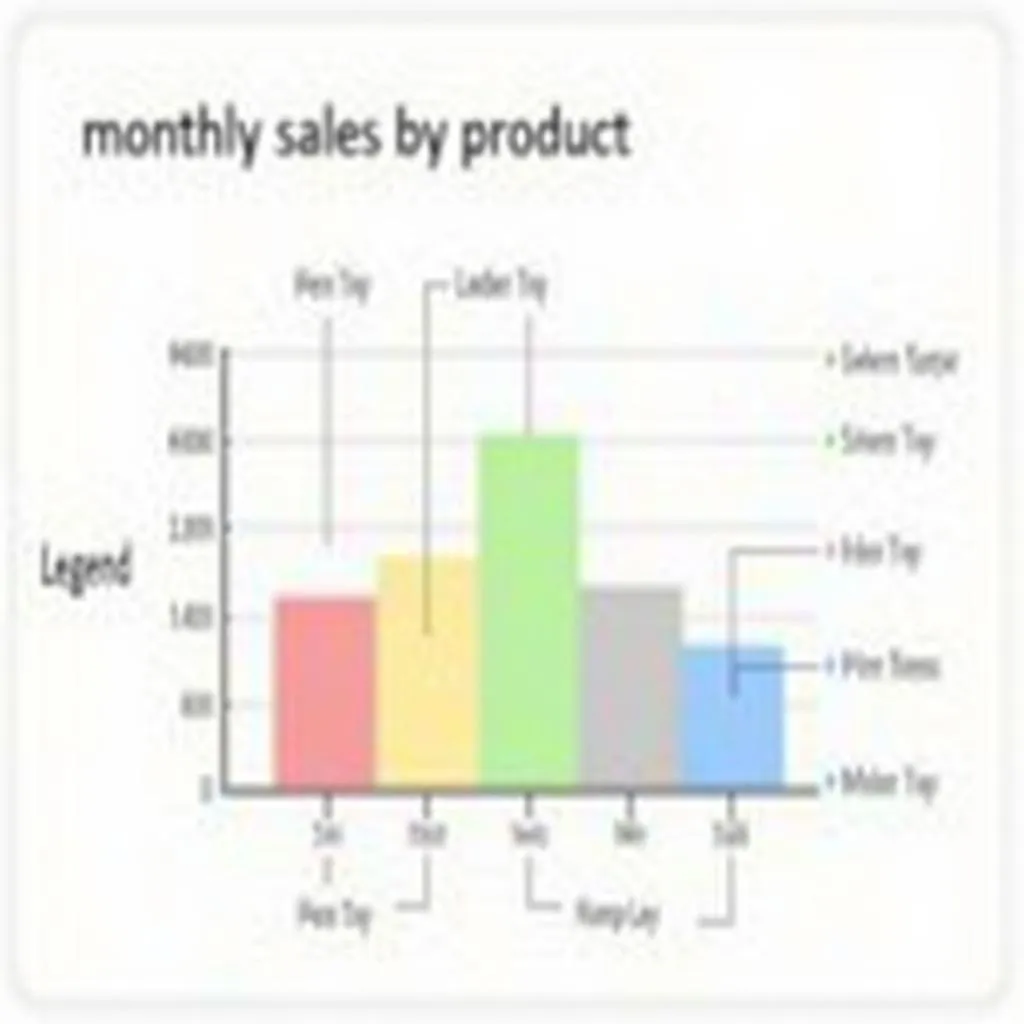Understanding Bar Charts in IELTS Writing Task 1
Bar charts are a common visual representation in IELTS Writing Task 1. They display data using rectangular bars of varying lengths, making it easy to compare different categories or time periods. To effectively describe bar charts, you need a robust vocabulary that allows you to accurately interpret and explain the information presented.
Key Components of Bar Charts
Before diving into specific vocabulary, it’s essential to understand the main elements of a bar chart:
- Axes: The horizontal (x-axis) and vertical (y-axis) lines that form the chart’s framework.
- Bars: Rectangular shapes representing data values.
- Legend: A key explaining what each bar or color represents.
- Title: The chart’s main heading, indicating the subject of the data.
- Labels: Text describing categories on the x-axis and values on the y-axis.

Essential Vocabulary for Describing Bar Charts
Verbs for Data Representation
- Show: “The chart shows the sales figures for different products.”
- Illustrate: “The bar graph illustrates the population growth over ten years.”
- Depict: “The data depicted in the chart reveals a significant trend.”
- Represent: “Each bar represents the percentage of students in various age groups.”
- Compare: “The chart compares the income levels across five countries.”
Nouns for Chart Elements
- Axis/Axes: “The vertical axis displays the number of units sold.”
- Category: “The horizontal axis lists four main categories of expenditure.”
- Bar: “The tallest bar indicates the highest sales figure.”
- Value: “The values on the y-axis range from 0 to 100 million dollars.”
- Legend: “The legend shows that blue bars represent male participants.”
Adjectives for Describing Data
- Significant: “There was a significant increase in exports between 2010 and 2015.”
- Marginal: “Only a marginal difference exists between the two lowest values.”
- Substantial: “A substantial drop in sales occurred in the third quarter.”
- Gradual: “The chart shows a gradual rise in temperatures over the decade.”
- Dramatic: “There was a dramatic surge in online shopping during the pandemic.”
Phrases for Analyzing Trends and Patterns
Describing Increases
- “There was a sharp rise in…”
- “…experienced a steady growth from X to Y.”
- “…saw a considerable upward trend.”
- “…increased dramatically by X percent.”
- “…showed a gradual improvement over the period.”
Describing Decreases
- “A significant decline was observed in…”
- “…fell steadily throughout the year.”
- “…experienced a steep drop from X to Y.”
- “…decreased markedly by X units.”
- “…showed a downward trend over the five-year period.”
Describing Stability or Fluctuations
- “…remained relatively constant between X and Y.”
- “…fluctuated slightly around the X mark.”
- “…showed minor variations but overall remained stable.”
- “…experienced peaks and troughs throughout the period.”
- “…maintained a consistent level of around X units.”
Advanced Vocabulary for Higher Band Scores
To achieve higher band scores in IELTS Writing Task 1, incorporate more sophisticated vocabulary and phrases:
- Constitute: “Women constitute the majority of participants in all age groups.”
- Outperform: “Product A consistently outperformed its competitors in terms of sales.”
- Dominate: “The 25-34 age group dominates the chart, representing over 40% of the total.”
- Plateau: “After a sharp rise, the figures plateaued at around 500 units per month.”
- Culminate: “The upward trend culminated in a peak of 10,000 visitors in August.”
Comparative Language
- “In comparison to X, Y shows a more pronounced increase.”
- “While X remained stable, Y exhibited significant fluctuations.”
- “The disparity between X and Y widened considerably over the period.”
- “X consistently outpaced Y in terms of growth rate.”
- “The gap between the highest and lowest values narrowed towards the end of the period.”
Tips for Using Bar Chart Vocabulary Effectively
- Accuracy: Ensure your vocabulary choices accurately reflect the data shown.
- Variety: Use a range of terms to avoid repetition and demonstrate linguistic diversity.
- Context: Choose words that are appropriate for the specific data and trends presented.
- Precision: Use specific numbers and percentages when describing significant changes or comparisons.
- Coherence: Organize your description logically, moving from general observations to specific details.
Common Pitfalls to Avoid
- Overinterpretation: Stick to describing what you see without speculating on causes or implications.
- Repetition: Avoid using the same words or phrases repeatedly throughout your response.
- Inconsistency: Maintain consistency in tense and terminology throughout your writing.
- Inaccuracy: Double-check your understanding of vocabulary to ensure you’re using terms correctly.
- Overlooking key information: Make sure to cover all significant aspects of the chart, including any notable exceptions or outliers.
Practice Exercises for Mastering Bar Chart Vocabulary
To improve your skills in describing bar charts, try these exercises:
- Vocabulary matching: Create flashcards with terms and their definitions or examples.
- Trend description: Find sample bar charts and practice writing short descriptions focusing on specific trends.
- Comparative analysis: Compare two different bar charts and describe the similarities and differences using appropriate vocabulary.
- Timed practice: Set a timer for 20 minutes and write a full Task 1 response to a bar chart question, focusing on using varied and accurate vocabulary.
- Peer review: Exchange your written descriptions with a study partner and provide feedback on each other’s vocabulary usage.
By mastering these vocabulary skills and practicing regularly, you’ll be well-equipped to tackle any bar chart that appears in your IELTS Writing Task 1. Remember, the key is not just knowing the words, but using them appropriately and effectively to clearly communicate the information presented in the chart.